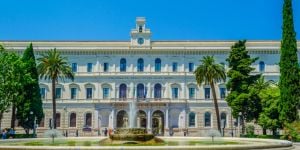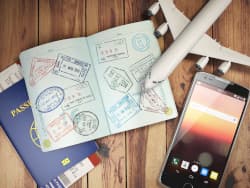
Milan is not only the Italian capital of fashion, finance and technology, but it is also the city of expatriates, including many international students. Student life in Milan is both exciting and demanding, as studying abroad, in itself, is an adventure that requires daily adaptation. Nevertheless, despite Milan's high cost of living, the rewards are great: a first-class education and extraordinary professional opportunities.
Adapting to student life in Milan
Italy, including Milan and Rome, is one of the favorite destinations for European students in general for an Erasmus experience. Its way of life, its cultural richness but also the high-level education system make Milan an ideal destination to enrich one's higher education.
Excitement is normal when you move to a foreign country, even to study. This is especially true in Milan, which hosts more Italian and international students and exchange programs than any other city in Italy. The reason is simple: Milan offers a wide range of opportunities through its public and private universities.
However, keep in mind that Milan is not a cheap city compared to the rest of Italy and Europe. Still, it can be rewarding for those willing to make sacrifices for their studies. In addition, the formalities can be complex, so if you are planning to do an Erasmus in Milan, make sure you contact your university, school, or other institution, as well as your country's consulate in Italy, for administrative assistance before you leave.
Student accommodation in Milan
Many students in Milan live close to their university, in flats or shared rooms. University areas are easier to socialize in, safer, and well-connected to bars and supermarkets. The Erasmus office at your university in Milan usually has a network of landlords who rent studios or rooms to international students.
It is also possible to get university accommodation in Milan. For example, the Università degli Studi di Milano (UniMi) provides accommodation for Erasmus students who are officially registered through the exchange program. This must be requested from your university's office. The length of stay will depend on the agreement between your home university and the university in Milan.
Universities in Milan
Public universities in Milan
The leading public universities in Milan are:
University of Milan (UniMi): UniMi offers around 700 accommodation places in the university's residences and flats yearly for a maximum of €2,750 per year. The places are available for an average of 11 months and are allocated to scholarship holders based on merit and the financial income of the student's family.
Università degli Studi di Milano Bicocca: the university offers support for shared flats, allowing students to live there at a reduced price.
Politecnico di Milano (PoliMi): it offers the possibility to reside in its "case dello studente", accommodation and residences for students.
Accademia di Belle Arti di Brera: the Academy allows students whose families reside abroad and some students whose families reside in Italy to benefit from accommodation provided by the institution. The former are directly eligible as they are defined as fuori sede (literally "off-site") students, while the latter have to pass a competitive examination to benefit from this status. The Academy provides a limited number of places (about 44).
Students at public universities in Milan have the possibility to apply for a scholarship granted by the Lombardy Region: the DSU (Diritto allo Studio Universitario). The scholarships are awarded annually, through a competitive process, to students who meet specific requirements in terms of merit (number of credits) and income, and provided that they are regularly enrolled in full-time courses.
Private universities in Milan
The leading private universities in Milan are:
- Università Commerciale Luigi Bocconi;
- Università Cattolica del Sacro Cuore (UniCatt);
- IULM, University of Languages and Communication;
- Università Vita San Raffaele (UniSR).
These universities offer the possibility to reside in some of their student residences. Again, accommodation depends on the merit and economic situation of students and their families. For example, UniCatt has a list of guesthouse accommodations (Foresteria) or hall of residence accommodations with which it has established agreements. This allows for discounts of up to 50% off the standard rates. These are called Campus In-Domus or Camplus.
Student accommodation in Milan
Renting a flat in Milan
Renting a flat or room is the most popular option for students in Milan. Choosing to be independent means being able to choose your own neighborhood and follow your own rules. For more comfort in everyday life, it is advisable to choose neighborhoods close to the universities, taking into account the quality of public transport. Some websites allow you to find accommodation in Milan independently, for example, Dotstay or Roomtastic.
The most popular areas in Milan to rent a room or a flat are Bicocca in the north-east, Porta Romana in the south, Porta Genova in the Navigli district, Città Studi and Lambrate in the east, where the average rent for a single room is 500 euros. Although Milan's city center is attractive, it is also the most expensive, chaotic, and touristy, so it is not advisable to look for accommodation there.
In Milan, and the rest of Italy, it is common for students to share a studio or even a room. This is mainly for economic reasons but also because accommodation can sometimes be scarce in the most sought-after areas. So, try to plan ahead if you are planning to go on Erasmus exchange in Milan.
The most popular areas in Milan
Whether you are an international student or an Erasmus student in Milan, certain areas are more popular than others for going out with friends or just taking a stroll. First and foremost is the Navigli district, known for its vibrant nightlife, with its many bars serving Milanese aperitifs during happy hour. Also known for its vintage shops, flea market, and antiques, the Navigli area attracts design lovers to the adjoining Tortona district.
Another popular area for students and hipsters is the Colonne San Lorenzo area with Corso di Porta Ticinese, a historic Milanese street dotted with trendy and vintage ephemeral shops. The area is also home to many original bars and restaurants.
Isola is also a vibrant area of Milan near Garibaldi station. There are futuristic towers, apartment buildings and a shopping mall. It is also home to the Bosco Verticale, an apartment building covered in vegetation. Further on, in the fashionable and alternative district, there are many bars and restaurants.
The Brera district is also very popular, especially with the students of the Academy of Fine Arts. The area is chic but preserves its historical, literary and artistic soul. There are many art galleries, designers and craftsmen in a maze of small streets.
Formalities for international students in Milan
As an international student in Milan, you will have to deal with administrative formalities. But don't panic; your university will be able to give you sound advice on how to overcome the slow and complex procedures. In any case, as an expatriate in Milan, you should apply for the following from the Italian Consulate in your home country before leaving:
- A Codice Fiscale (unique personalized tax code) ;
- A visa to study in Italy if you come from a country outside the European Union (see our article "Long-term visas for Italy");
and once in Milan:
- Residence permit, permesso di soggiorno (for non-European students and renewable every year) to be requested within eight days of your arrival in Milan from the Police Headquarters;
- Health insurance from the National Health Service (included in the cost of the residence permit).
To apply for the student residence permit in Italy, make sure you provide the following documents:
- a duly completed application form;
- your passport, or any other valid document, together with your visa;
- a copy of the same document;
- four recent passport-size photos;
- documents required according to the type of residence permit requested (work, study, etc.);
- payment receipt of the processing fee for obtaining the student residence permit (from €80 to €130, depending on the type and duration of the stay, plus administrative costs and tax stamps, €30 and €16, respectively).
Cost of living in Milan
Regarding the cost of living in Milan, excluding accommodation, you should expect to pay a minimum of €350-400 per month. Students under 27 years of age are eligible for discounts for public services, such as public transport, bicycle hire, and some sports facilities. All you need to do is show your student card when accessing or registering for these services. There are also a few cheap bars and restaurants, but in Milan, they are not as common as in some European capitals. However, you will find small restaurants such as piadineria, pizzeria al taglio, birreria (where you can drink beer and eat sandwiches and/or burgers) or paninoteca, but also snacks with Asian cuisine. Some bars and restaurants have agreements with Milanese universities; contact the institution concerned for a list. The Accademia di Belle Arti di Brera, for example, publishes a list of such restaurants.
To make ends meet, some students in Milan work part-time as waiters, babysitters, or salespersons. While this entry into the labor market can be unsettling, it is a necessary step, as it can open the door to other professional opportunities. Note also that internships are poorly paid in Milan, around 500 euros per month, but this also depends on the company where you do your internship.
Discounts for international students in Milan
Milan offers many activities for international students. As a new expat in the city as part of your studies, consider joining the Erasmus Student Network (ESN) community, which organizes visits to the surrounding cities, aperitifs, and affordable events to meet other expats. To benefit from a broader range of benefits, consider applying for the ESN Card, which will give you discounts on a wide range of services.
For international students keen on discovering the Milanese culture, the city also offers discounts for student card holders.
Transportation in Milan
Another important tip for students is that train fares tend to rise during holidays and weekends. Railway operators such as Trenitalia offer discounts, but they are modest and, therefore, not very popular. The Italian coach network is a reliable and economical way to travel between regions and cities in Italy. Many companies, including Itabus and Marino Autolinee, also offer air conditioning and free Wi-fi. Flixbus is also popular with students who like to travel around European cities, but fares vary according to the season.
To sum up, Milan is not a cheap city; you have to look for the right activities, the right events and, above all, good connections. Indeed, word of mouth works well in Italy, so try not to isolate yourself but rather to meet other young people who are going through the same experience as you in order to build a social circle and make new friends in Milan. Enjoy your new host city, its pleasant climate, its dynamism, its terraces, its cultural offer and the outdoor activities it offers because simplicity and authenticity are also part of the expat experience!
Useful links :
We do our best to provide accurate and up to date information. However, if you have noticed any inaccuracies in this article, please let us know in the comments section below.










